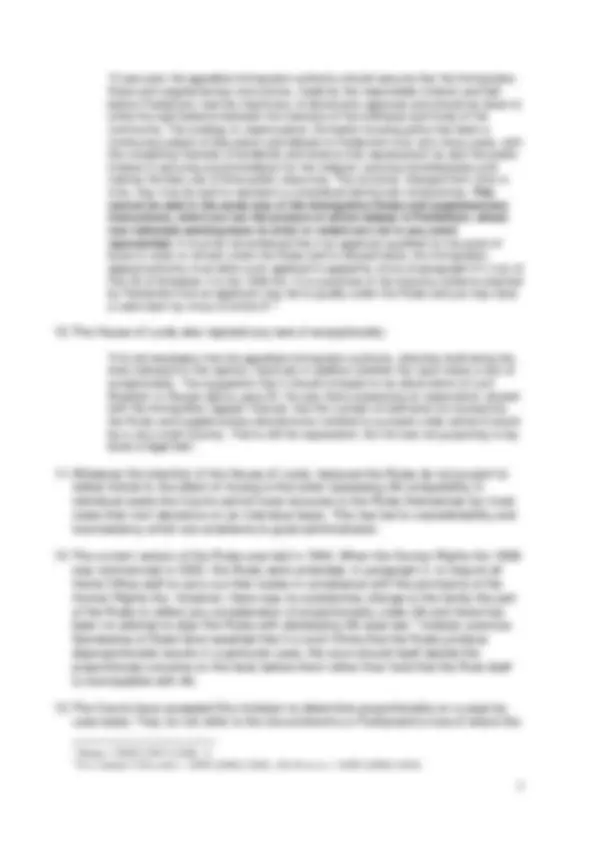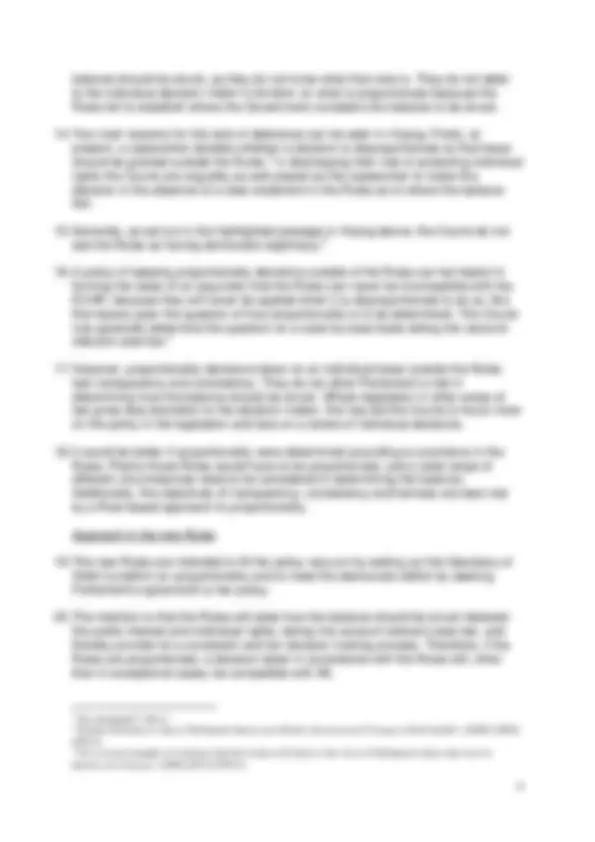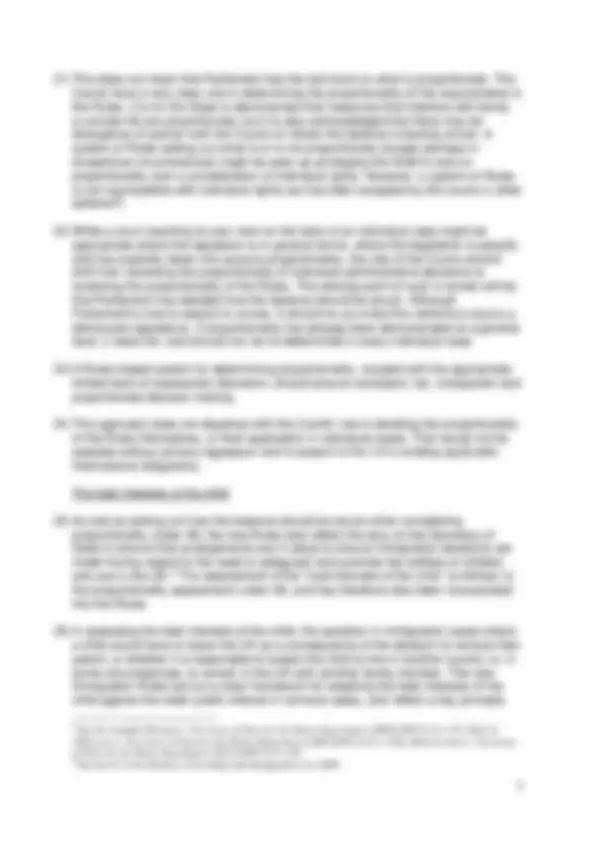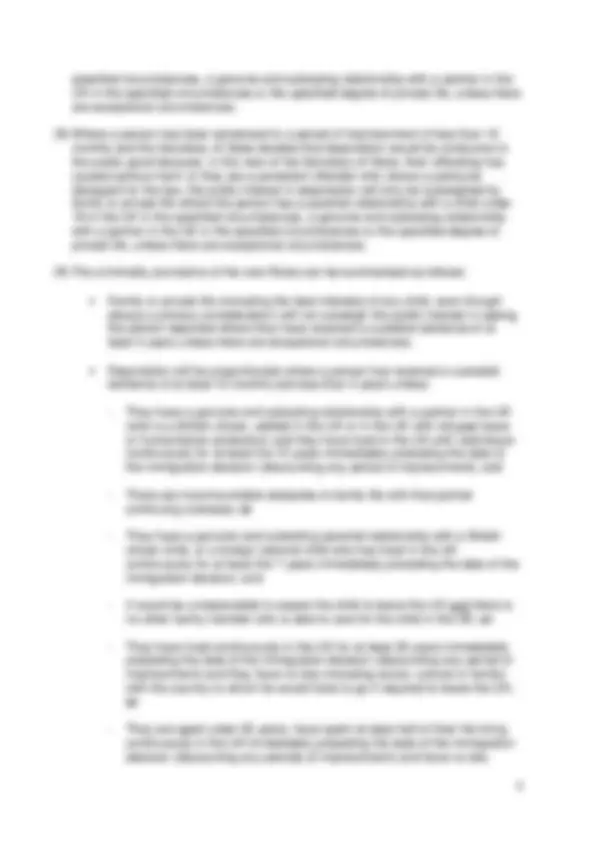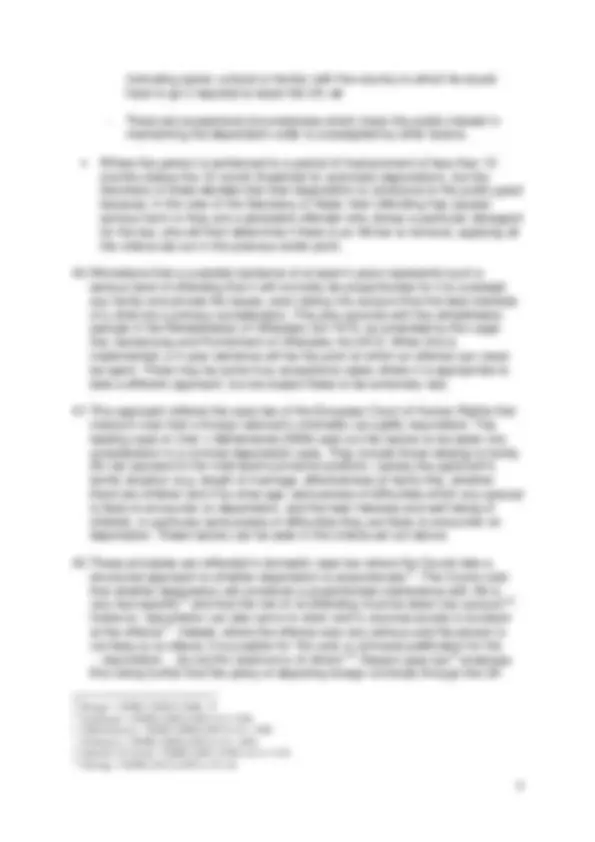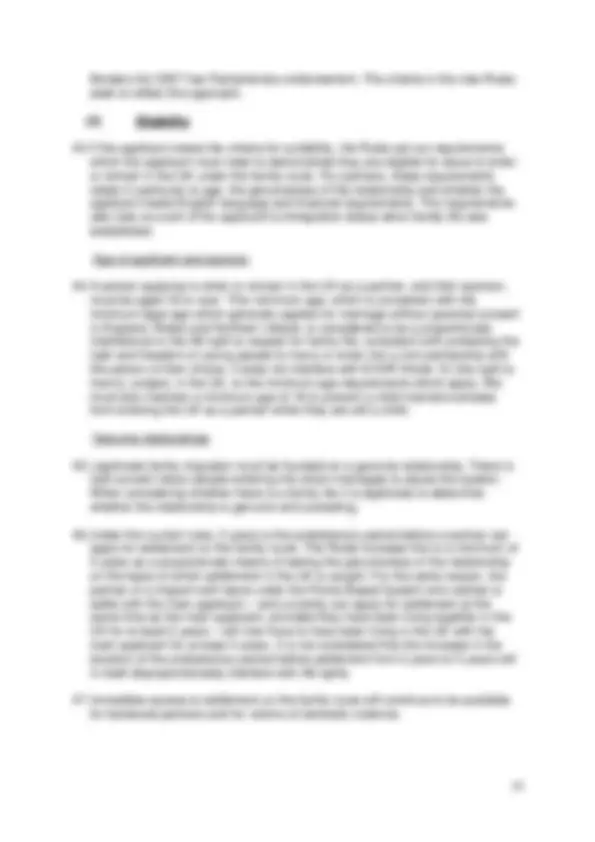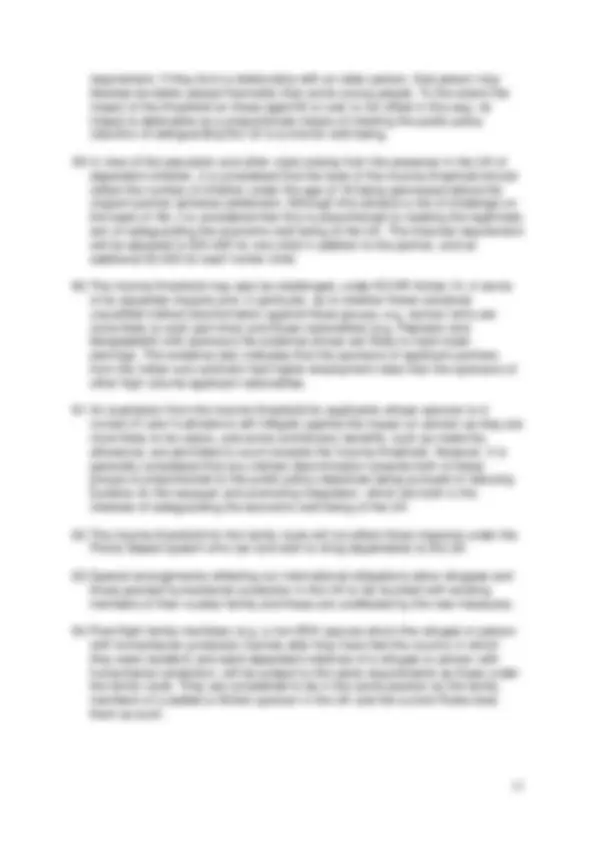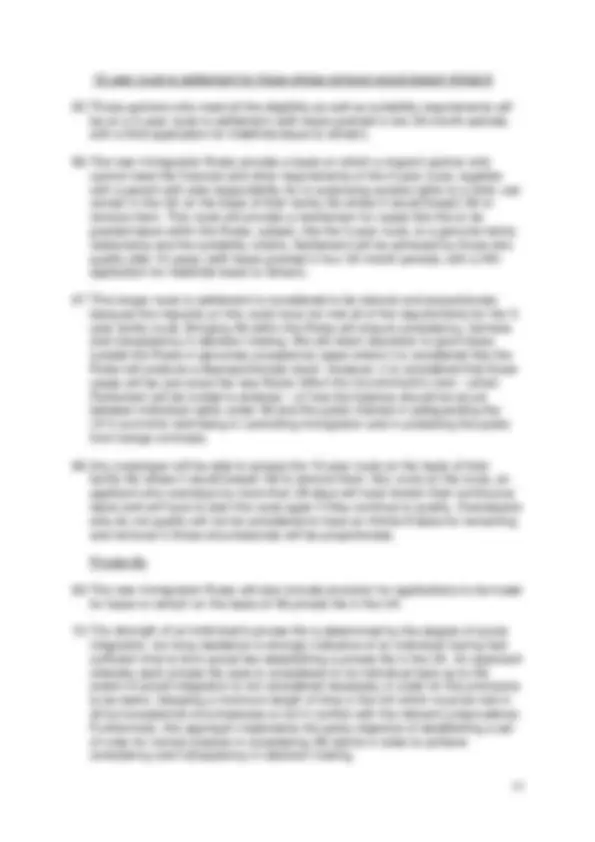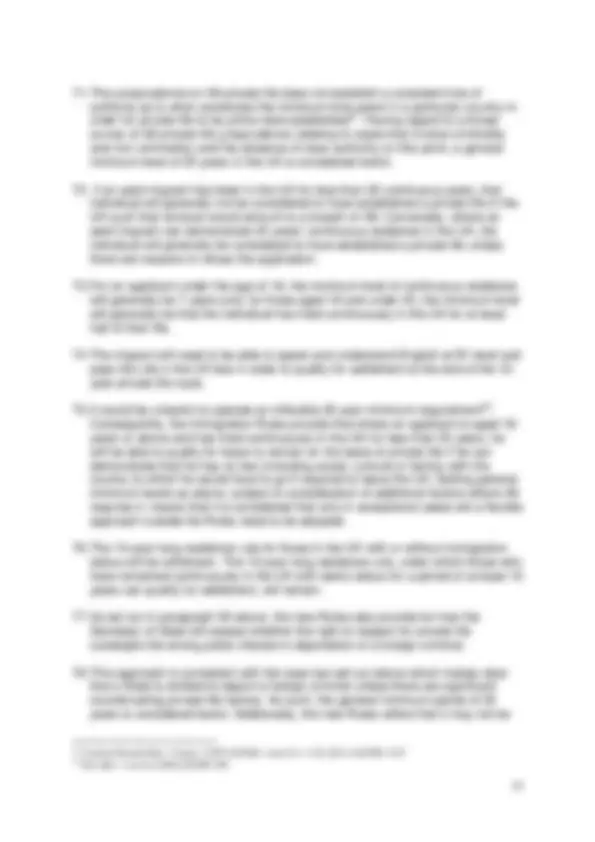Download European Convention on Human Rights: Immigration Rules and Family Life and more Study notes Human Rights in PDF only on Docsity!
IMMIGRATION RULES ON FAMILY AND PRIVATE LIFE (HC 194)
GROUNDS OF COMPATIBILITY WITH ARTICLE 8 OF
THE EUROPEAN CONVENTION ON HUMAN RIGHTS
STATEMENT BY THE HOME OFFICE
A. Introduction
- This statement addresses issues arising under Article 8 of the European Convention on Human Rights (ECHR) (“A8”) in relation to the Statement of Changes in Immigration Rules (HC 194) (“the Rules”) which relate to those seeking to enter or remain in the UK on the basis of their family life with a person who is a British citizen, is settled in the UK or has refugee leave or humanitarian protection, and those seeking to remain on the basis of their private life in the UK. There are other changes to the Rules which are not addressed here.
- This statement will first set out the approach being taken to A8 in the new Rules and explain how that differs from the current approach. It will then address the A issues that arise from the specific requirements in the new Rules and set out why those requirements are compatible with ECHR rights.
B. The current approach to Article 8
- The current Rules do not provide a clear and comprehensive framework for considering family life and private life in compliance with A8. In particular, they do not reflect adequately the factors which can weigh in favour of and against a person’s A8 claim and how the balance should be struck between the public interest and individual rights. Currently family life applications are first considered under the Rules and, if the application does not meet the requirements of the Rules, the decision-maker then considers whether the decision is compatible with A8. If the decision-maker thinks the decision is not compatible with A8, or the Courts find that to be the case, leave is granted outside the Rules.
- A8 states:
“(1) Everyone has the right to respect for his private and family life, his home and his correspondence.
(2) There shall be no interference by a public authority with the exercise of this right except such as is in accordance with the law and is necessary in a democratic society in the interests of national security, public safety or the economic well-being of the country, for the prevention of disorder or crime, for the protection of health or morals, or for the protection of the rights and freedoms of others.”
- A8 is a qualified right. The key test that both the decision-maker and the Courts apply in assessing the A8 compatibility of an immigration decision is whether the decision is proportionate. Executive decisions in a variety of spheres are challenged in court as being disproportionate, and thus in breach of ECHR rights.
Usually, the Courts show deference to the judgment of the decision-maker. However, in the context of immigration decisions on A8, the Courts are impeded from doing so by the failure of the Immigration Rules to reflect any consideration of proportionality under A8. Therefore, the first question is whether the changes to the Rules can affect that approach, and if they can, whether it is compatible with ECHR rights for them to seek to do so.
- The Rules are a statement of the Secretary of State’s practice. Their role and importance is summarised by the House of Lords in Huang :
“There will, in almost any case, be certain general considerations to bear in mind: the general administrative desirability of applying known rules if a system of immigration control is to be workable, predictable, consistent and fair as between one applicant and another; the damage to good administration and effective control if a system is perceived by applicants internationally to be unduly porous, unpredictable or perfunctory; the need to discourage non-nationals admitted to the country temporarily from believing that they can commit serious crimes and yet be allowed to remain; the need to discourage fraud, deception and deliberate breaches of the law; and so on.”
- The proportionality test involves asking:
(a) Does the measure serve a legitimate aim? (b) Was the measure rationally connected to the aim? (c) Did the measure go no further than was necessary to achieve the aim? And (d) Was a fair balance struck between the public interest and the rights of the individual?^1
- The approach the Courts initially adopted in immigration cases when considering proportionality and the Rules is demonstrated in the following passage (emphasis added):
“In such a case the adjudicator is not ignoring or overriding the Rules. On the contrary it is a signal feature of his task that he is bound to respect the balance between public interest and private right struck by the Rules with Parliament's approval. That is why he is only entitled on Article 8 grounds to favour an appellant outside the Rules where the case is truly exceptional. This, not Wednesbury or any revision of Wednesbury , represents the real restriction which the law imposes on the scope of judgment allowed to the adjudicator. It is not a question of his deferring to the Secretary of State's judgment of proportionality in the individual case. The adjudicator's decision of the question whether the case is truly exceptional is entirely his own. He does defer to the Rules; for this approach recognises that the balance struck by the Rules will generally dispose of proportionality issues arising under Article 8; but they are not exhaustive of all cases. There will be a residue of truly exceptional instances. In our respectful view such an approach is also reflected in Lord Bingham's words in Razgar , which we have already cited”.^2
- However, the House of Lords subsequently rejected that approach (emphasis added):
(^1) See Huang v SSHD [2007] UKHL 11 and earlier case law. (^2) Huang & Others v SSHD [2005] EWCA Civ 105
balance should be struck, as they do not know what that view is. They do not defer to the individual decision-maker’s decision on what is proportionate because the Rules fail to establish where the Government considers the balance to be struck.
- Two main reasons for this lack of deference can be seen in Huang. Firstly, at present, a caseworker decides whether a decision is disproportionate so that leave should be granted outside the Rules.^5 In discharging their role of protecting individual rights the Courts are arguably as well placed as the caseworker to make this decision in the absence of a clear statement in the Rules as to where the balance lies.
- Secondly, as set out in the highlighted passage in Huang above, the Courts do not see the Rules as having democratic legitimacy.^6
- A policy of keeping proportionality decisions outside of the Rules can be helpful in forming the basis of an argument that the Rules can never be incompatible with the ECHR, because they will never be applied when it is disproportionate to do so. But that leaves open the question of how proportionality is to be determined. The Courts now generally determine the question on a case-by-case basis taking into account relevant case law.^7
- However, proportionality decisions taken on an individual basis outside the Rules lack transparency and consistency. They do not allow Parliament a role in determining how the balance should be struck. Where legislation in other areas of law gives less discretion to the decision-maker, this has led the Courts to focus more on the policy in the legislation and less on a review of individual decisions.
- It would be better if proportionality were determined according to provisions in the Rules. Plainly those Rules would have to be proportionate, and a wide range of different circumstances need to be considered in determining the balance. Additionally, the objectives of transparency, consistency and fairness are best met by a Rule-based approach to proportionality.
Approach in the new Rules
- The new Rules are intended to fill the policy vacuum by setting out the Secretary of State’s position on proportionality and to meet the democratic deficit by seeking Parliament’s agreement to her policy.
- The intention is that the Rules will state how the balance should be struck between the public interest and individual rights, taking into account relevant case law, and thereby provide for a consistent and fair decision-making process. Therefore, if the Rules are proportionate, a decision taken in accordance with the Rules will, other than in exceptional cases, be compatible with A8.
(^5) See paragraph 3 above (^6) Greater deference is due to Parliament than to an official: International Transport Roth GmbH v SSHD [2002] EWCA. (^7) For a recent example of evidence that the Courts will defer to the view of Parliament where that view is known, see Gurung v SSHD [2012] EWCA.
- This does not mean that Parliament has the last word on what is proportionate. The Courts have a very clear role in determining the proportionality of the requirements in the Rules. It is for the State to demonstrate that measures that interfere with family or private life are proportionate, but it is also acknowledged that there may be divergence of opinion with the Courts on where the balance is lawfully struck. A system of Rules setting out what is or is not proportionate (except perhaps in exceptional circumstances) might be seen as privileging the State’s view on proportionality over a consideration of individual rights. However, a system of Rules is not incompatible with individual rights (as has been accepted by the courts in other spheres^8 ).
- While a court reaching its own view on the facts of an individual case might be appropriate where the legislation is in general terms, where the legislation is specific and has explicitly taken into account proportionality, the role of the Courts should shift from reviewing the proportionality of individual administrative decisions to reviewing the proportionality of the Rules. The starting-point of such a review will be that Parliament has decided how the balance should be struck. Although Parliament’s view is subject to review, it should be accorded the deference due to a democratic legislature. If proportionality has already been demonstrated at a general level, it need not, and should not, be re-determined in every individual case.
- A Rules-based system for determining proportionality, coupled with the appropriate limited level of caseworker discretion, should ensure consistent, fair, transparent and proportionate decision-making.
- This approach does not dispense with the Courts’ role in deciding the proportionality of the Rules themselves, or their application in individual cases. That would not be possible without primary legislation and is subject to the UK’s existing applicable international obligations.
The best interests of the child
- As well as setting out how the balance should be struck when considering proportionality under A8, the new Rules also reflect the duty on the Secretary of State to ensure that arrangements are in place to ensure immigration decisions are made having regard to the need to safeguard and promote the welfare of children who are in the UK.^9 The assessment of the “best interests of the child” is intrinsic to the proportionality assessment under A8, and has therefore also been incorporated into the Rules.
- In assessing the best interests of the child, the question in immigration cases where a child would have to leave the UK as a consequence of the decision to remove their parent, is whether it is reasonable to expect the child to live in another country or, in some circumstances, to remain in the UK with another family member. The new Immigration Rules set out a clear framework for weighing the best interests of the child against the wider public interest in removal cases, and reflect a key principle
(^8) See for example Mongoto v Secretary of State for the Home Department [2005] EWCA Civ 751; Rudi & TI(Kosovo) v Secretary of State for the Home Department [2007] EWCA Civ 1326; Miah & others v Secretary of State for the Home Department [2012] EWCA Civ 261 (^9) Section 55 of the Borders, Citizenship and Immigration Act 2009
- The suitability criteria serve a number of legitimate aims, including the interests of national security and public safety, the prevention of disorder or crime and the protection of health. Several of the criteria in relation to suitability relate to whether the applicant’s presence in the UK is conducive to the public good. This can cover a range of factors and the decision itself is not amenable to a Rules-based approach, requiring a range of factors relating to the public interest: national security, unacceptable behaviour, medical reasons, etc to be taken into account. The new Rules do not set out how the balance should be struck in relation to these criteria because the criteria themselves require a balance to be struck between the public interest and individual rights.
Criminality
- Criminality is also relevant to suitability. Refusal of those who commit criminal offences serves the legitimate aim of the prevention of crime and disorder and the protection of the rights and freedoms of others. It is also an area where Parliament has set out its views on the public interest in section 32(4) of the UK Borders Act 2007 which states (where section 32(1) applies):
“...the deportation of a foreign criminal is conducive to the public good.”
- However, section 32 of that Act also provides that the Secretary of State is not required to make a deportation order if an exception applies, and the exceptions include where deportation would breach a person’s ECHR rights. The threshold for the duty to deport under section 32 is a sentence of imprisonment of at least 12 months.^12 The Courts have accepted that this legislative statement of the public interest has to be accepted as the starting-point for the assessment of proportionality by the Courts,^13 but there is no further indication in that Act or the existing Rules as to how the balance should then be struck. Similarly there is no indication in the existing Rules as to how the A8 balance should be struck in cases where a person may be deported under the residual discretionary powers under the Immigration Act 1971 (where a person does not fall within section 32 of the 2007 Act).
- The new Rules set out how the Government considers that the balance should be struck when assessing proportionality in a case involving a foreign criminal – both in cases concerning automatic deportation under section 32 of the 2007 Act and also in cases where discretion is exercised under the Immigration Act 1971.
- The new Rules provide that cases where the person has been sentenced to at least 4 years, the seriousness of the offence means that the very strong public interest in deportation will outweigh a person’s family life in the UK unless there are exceptional circumstances.
- Where a person has been sentenced to a period of imprisonment of at least 12 months and less than 4 years, the seriousness of the offence means that there is a strong public interest in deportation which is only outweighed by family or private life where the person has a parental relationship with a child under 18 in the UK in the
(^12) Section 32(3) also refers to conviction for an offence specified by order, but there is currently no such order. (^13) See RU (Bangladesh) v SSHD [2011] EWCA; although the recent case of Gurung v SSHD [2012] EWCA suggests the effect when assessing proportionality is still open to argument.
specified circumstances, a genuine and subsisting relationship with a partner in the UK in the specified circumstances or the specified degree of private life, unless there are exceptional circumstances.
- Where a person has been sentenced to a period of imprisonment of less than 12 months and the Secretary of State decides that deportation would be conducive to the public good because, in the view of the Secretary of State, their offending has caused serious harm or they are a persistent offender who shows a particular disregard for the law, the public interest in deportation will only be outweighed by family or private life where the person has a parental relationship with a child under 18 in the UK in the specified circumstances, a genuine and subsisting relationship with a partner in the UK in the specified circumstances or the specified degree of private life, unless there are exceptional circumstances.
- The criminality provisions of the new Rules can be summarised as follows:
Family or private life (including the best interests of any child, even though always a primary consideration) will not outweigh the public interest in seeing the person deported where they have received a custodial sentence of at least 4 years unless there are exceptional circumstances.
Deportation will be proportionate where a person has received a custodial sentence of at least 12 months and less than 4 years unless:
- They have a genuine and subsisting relationship with a partner in the UK (who is a British citizen, settled in the UK or in the UK with refugee leave or humanitarian protection) and they have lived in the UK with valid leave continuously for at least the 15 years immediately preceding the date of the immigration decision (discounting any period of imprisonment); and
- There are insurmountable obstacles to family life with that partner continuing overseas; or
- They have a genuine and subsisting parental relationship with a British citizen child, or a foreign national child who has lived in the UK continuously for at least the 7 years immediately preceding the date of the immigration decision; and
- It would be unreasonable to expect the child to leave the UK and there is no other family member who is able to care for the child in the UK; or
- They have lived continuously in the UK for at least 20 years immediately preceding the date of the immigration decision (discounting any period of imprisonment) and they have no ties (including social, cultural or family) with the country to which he would have to go if required to leave the UK; or
- They are aged under 25 years, have spent at least half of their life living continuously in the UK immediately preceding the date of the immigration decision (discounting any periods of imprisonment) and have no ties
Borders Act 2007 has Parliamentary endorsement. The criteria in the new Rules seek to reflect this approach.
(ii) Eligibility
- If the applicant meets the criteria for suitability, the Rules set out requirements which the applicant must meet to demonstrate they are eligible for leave to enter or remain in the UK under the family route. For partners, these requirements relate in particular to age, the genuineness of the relationship and whether the applicant meets English language and financial requirements. The requirements also take account of the applicant’s immigration status when family life was established.
Age of applicant and sponsor
- A person applying to enter or remain in the UK as a partner, and their sponsor, must be aged 18 or over. This minimum age, which is consistent with the minimum legal age which generally applies for marriage without parental consent in England, Wales and Northern Ireland, is considered to be a proportionate interference in the A8 right to respect for family life, consistent with protecting the right and freedom of young people to marry or enter into a civil partnership with the person of their choice. It does not interfere with ECHR Article 12 (the right to marry), subject, in the UK, to the minimum age requirements which apply. We must also maintain a minimum age of 18 to prevent a child married overseas from entering the UK as a partner whilst they are still a child.
Genuine relationships
- Legitimate family migration must be founded on a genuine relationship. There is real concern about people entering into sham marriages to abuse the system. When considering whether there is a family life it is legitimate to determine whether the relationship is genuine and subsisting.
- Under the current rules, 2 years is the probationary period before a partner can apply for settlement on the family route. The Rules increase this to a minimum of 5 years as a proportionate means of testing the genuineness of the relationship on the basis of which settlement in the UK is sought. For the same reason, the partner of a migrant with leave under the Points Based System who wishes to settle with the main applicant – and currently can apply for settlement at the same time as the main applicant, provided they have been living together in the UK for at least 2 years – will now have to have been living in the UK with the main applicant for at least 5 years. It is not considered that the increase in the duration of the probationary period before settlement from 2 years to 5 years will in itself disproportionately interfere with A8 rights.
- Immediate access to settlement on the family route will continue to be available for bereaved partners and for victims of domestic violence.
English language
- English language is the corner-stone of integration, enabling participation in British society and improving employability.
- Since 2010, the Government has increased language requirements across the immigration system, including by introducing, in November 2010, a requirement for those applying to enter or remain in the UK as a partner of a British citizen or person settled in the UK to demonstrate that they can speak and understand basic English (Common European Framework of Reference level A1). This requirement will remain. In Chapti^20 the Divisional Court found that it was a proportionate interference in family life, did not interfere with ECHR Article 12 (the right to marry) and was not discriminatory under ECHR Article 14.
- However, it is still possible for some groups to qualify for settlement with only a very limited command of English. Therefore, from October 2013, all applicants for settlement not already required to do so will be required to demonstrate a knowledge of language and life in the UK by passing the Life in the UK test and by presenting a speaking and listening qualification at intermediate level (Common European Framework of Reference level B1) or above. This language requirement, together with a knowledge of the values that underlie British society, will help ensure that those who settle here are able to participate in British life and are better able to gain employment.
- The main group affected will be migrant partners. Those with a physical or mental condition that prevents them from meeting the requirement will be exempted, as will be those aged 65 or over. Achieving a B1 level qualification may be challenging and may require a sustained period of study. However, under the new system there should be sufficient time for the majority of applicants. A failure to achieve settlement because a partner fails the Life in the UK test or the B English language requirement will not result in removal of the migrant as this would almost certainly be a disproportionate interference with A8. If they fail only the knowledge of language and life in the UK requirement at the indefinite leave to remain stage, applicants will be granted further leave of 30 months to give them more time to evidence they meet the requirement, at which point they can immediately apply for indefinite leave to remain if they continue to meet the other requirements.
Financial requirement
- The Government considers that those who choose to establish their family life in the UK by sponsoring a non-EEA partner to settle here should have the financial wherewithal to be able to support themselves and their partner without being a burden on the taxpayer. Moreover, the sponsor should bear the financial responsibility of ensuring that the migrant is well enough supported to able to integrate and play a full part in British society.
(^20) Chapti & Ors v SSHD [2011] EWHC 3370
requirement. If they form a relationship with an older person, that person may likewise be better placed financially than some young people. To the extent the impact of the threshold on those aged 65 or over is not offset in this way, its impact is defensible as a proportionate means of meeting the public policy objective of safeguarding the UK’s economic well-being.
- In view of the education and other costs arising from the presence in the UK of dependent children, it is considered that the level of the income threshold should reflect the number of children under the age of 18 being sponsored before the migrant partner achieves settlement. Although this attracts a risk of challenge on the basis of A8, it is considered that this is proportionate to meeting the legitimate aim of safeguarding the economic well-being of the UK. The financial requirement will be adjusted to £22,400 for one child in addition to the partner, and an additional £2,400 for each further child.
- The income threshold may also be challenged, under ECHR Article 14, in terms of its equalities impacts and, in particular, as to whether these constitute unjustified indirect discrimination against those groups, e.g. women (who are more likely to work part-time) and those nationalities (e.g. Pakistani and Bangladeshi) with sponsors the evidence shows are likely to have lower earnings. The evidence also indicates that the sponsors of applicant partners from the Indian sub-continent had higher employment rates than the sponsors of other high volume applicant nationalities.
- An exemption from the income threshold for applicants whose sponsor is in receipt of carer’s allowance will mitigate against the impact on women as they are more likely to be carers, and some contributory benefits, such as maternity allowance, are permitted to count towards the income threshold. However, it is generally considered that any indirect discrimination towards both of these groups is proportionate to the public policy objectives being pursued of reducing burdens on the taxpayer and promoting integration, which are both in the interests of safeguarding the economic well-being of the UK.
- The income threshold for the family route will not affect those migrants under the Points Based System who can and wish to bring dependants to the UK.
- Special arrangements reflecting our international obligations allow refugees and those granted humanitarian protection in the UK to be reunited with existing members of their nuclear family and these are unaffected by the new measures.
- Post-flight family members (e.g. a non-EEA spouse whom the refugee or person with humanitarian protection marries after they have fled the country in which they were resident) and adult dependent relatives of a refugee or person with humanitarian protection, will be subject to the same requirements as those under the family route. They are considered to be in the same position as the family members of a settled or British sponsor in the UK and the current Rules treat them as such.
10-year route to settlement for those whose removal would breach Article 8
- Those partners who meet all the eligibility as well as suitability requirements will be on a 5-year route to settlement (with leave granted in two 30-month periods, with a third application for indefinite leave to remain).
- The new Immigration Rules provide a basis on which a migrant partner who cannot meet the financial and other requirements of the 5-year route, together with a parent with sole responsibility for or exercising access rights to a child, can remain in the UK on the basis of their family life where it would breach A8 to remove them. This route will provide a mechanism for cases like this to be granted leave within the Rules, subject, like the 5-year route, to a genuine family relationship and the suitability criteria. Settlement will be achieved by those who qualify after 10 years (with leave granted in four 30-month periods, with a fifth application for indefinite leave to remain).
- This longer route to settlement is considered to be rational and proportionate because the migrants on this route have not met all of the requirements for the 5- year family route. Bringing A8 within the Rules will ensure consistency, fairness and transparency in decision-making. We will retain discretion to grant leave outside the Rules in genuinely exceptional cases where it is considered that the Rules will produce a disproportionate result. However, it is considered that those cases will be rare since the new Rules reflect the Government’s view – which Parliament will be invited to endorse – of how the balance should be struck between individual rights under A8 and the public interest in safeguarding the UK’s economic well-being in controlling immigration and in protecting the public from foreign criminals.
- Any overstayer will be able to access the 10-year route on the basis of their family life where it would breach A8 to remove them. But, once on the route, an applicant who overstays by more than 28 days will have broken their continuous leave and will have to start the route again if they continue to qualify. Overstayers who do not qualify will not be considered to have an Article 8 basis for remaining and removal in those circumstances will be proportionate.
Private life
- The new Immigration Rules will also include provision for applications to be made for leave to remain on the basis of A8 private life in the UK.
- The strength of an individual’s private life is determined by the degree of social integration, but long residence is strongly indicative of an individual having had sufficient time to form social ties establishing a private life in the UK. An approach whereby each private life case is considered on its individual facts as to the extent of social integration is not considered necessary in order for the provisions to be lawful. Adopting a minimum length of time in the UK which must be met in all but exceptional circumstances is not in conflict with the relevant jurisprudence. Furthermore, this approach implements the policy objective of establishing a set of rules for normal practice in considering A8 claims in order to achieve consistency and transparency in decision-making.
proportionate to deport a young person who has lived in the UK for a significant period of time falling short of 20 years^23.
Other settlement changes
- Settlement – permanent residence in the UK and full access to the welfare system – is not an entitlement. The basis on which settlement can be achieved should therefore reward compliance with the rules, be fair as between different categories of migrant, and promote integration and participation in British society. The new Rules contain measures on settlement which we consider are compatible with A8.
- The new Rules abolish immediate settlement for the migrant partner where a couple have been living together for at least 4 years overseas and require them to complete 5 years’ probation in the UK before they can apply for settlement. Such a migrant partner may never have been to the UK or made any tax or National Insurance contribution and it is therefore unfair that they should get immediate settlement and full access to the welfare system.
- Non-EEA adult dependent relatives joining a person settled in the UK can give rise to significant NHS and social care costs. The new Rules make three changes to the current provisions for this category.
- First, the route will be closed to applicants seeking to switch in-country: anyone coming to the UK for a visit (up to 6 months) must expect to return home at the end of it.
- Second, the route will be limited to close family: parents, grandparents, sons, daughters, brothers and sisters. This means excluding uncles and aunts from the route, which does not affect significant numbers.
- Third, the routine expectation of settlement in the UK for parents and grandparents aged 65 or over who are financially dependent on a relative here will be ended. Only those who can demonstrate that, as a result of age, illness or disability, they require a level of long-term personal care that can only be provided in the UK by their relative here and without recourse to public funds, will be able to settle in the UK.
- This is reflects the intended thrust of the current rules applying to parents and grandparents aged under 65 (287 were granted in 2010-11) and to all other adult dependent relatives using the route, including those aged 65 or over (723 were granted in 2010-11, including 277 aged 65 or over).
- The UK sponsor will not be required to meet the new minimum income threshold in order to sponsor an adult dependent relative, who will, if they qualify, continue to be granted immediate settlement in the UK. If they qualify on the basis of their personal care needs, we do not wish to exclude them on economic grounds, subject to the sponsor being required to ensure that the relative will be
(^23) Uner v Netherlands [2006] ECHR 873 and Maslov v Austria [2008] ECHR 346
adequately maintained, accommodated and cared for without recourse to public funds and to give a 5-year undertaking to this effect.
Immigration status
- A8 does not require the Government to accept the preference of a family or couple to live in the UK and the UK retains the right to control immigration^24.
- The new Immigration Rules reflect the approach taken in the relevant jurisprudence as follows:
a) Where a person establishes a private or family life while they are in the UK illegally or while their immigration status here is precarious, that period of residence in the UK should be accorded less weight as a consequence of it being illegal or precarious in nature. This approach is supported by jurisprudence from the European Court of Human Rights in Strasbourg,^25 which also states that where private or family life is established whilst a person does not have lawful status, it is to be given less weight than private or family life established while a person is in the UK lawfully. Further, it is only in the most exceptional circumstances that the removal of the non-national family member will constitute a violation of Article 8 because their removal would be in the interests of the economic well-being of the country, by controlling illegal immigration.^26 Domestic jurisprudence takes a similar approach.^27
b) Where both parties were legally present in the UK at the time the relationship started but a subsequent event (most frequently the commission of a criminal offence) means that the removal of one party is pursued, different circumstances at the beginning of the relationship that forms the basis of the A8 claim mean that Strasbourg jurisprudence does not require the application of the exceptional circumstances test that it does in respect of relationships established while one party’s status in the UK is illegal or precarious. But it does take account of the gravity of the crime, amongst other factors, in considering whether the removal of the individual is in pursuit of the legitimate aims of public safety or the prevention of disorder or crime.^28
Conclusion
- It is the Department’s view that the new Rules on family life and private life are compatible with ECHR Article 8.
Home Office, 13 June 2012
(^24) Abdulaziz v UK (1985) 7 EHRR 471 (^25) Rodrigues da Silva, Hoogkamer v Netherlands (2007) 44 EHRR 72 (^26) Mitchell v UK (Application no.40447/98; Ajayi & Others v UK (Application no.27663/95); Konstantinov v
Netherlands [2007] 2FCR 194; Y v Russia (2010) 51 EHRR 21 (^27) JO(Uganda) & JT(Ivory Coast) v SSHD [2010] EWCA Civ 10 (^28) See Boultif v Switzerland (2001) 30 EHRR 50 and Uner v Netherlands [2006] ECHR 873for the test to be
applied.

